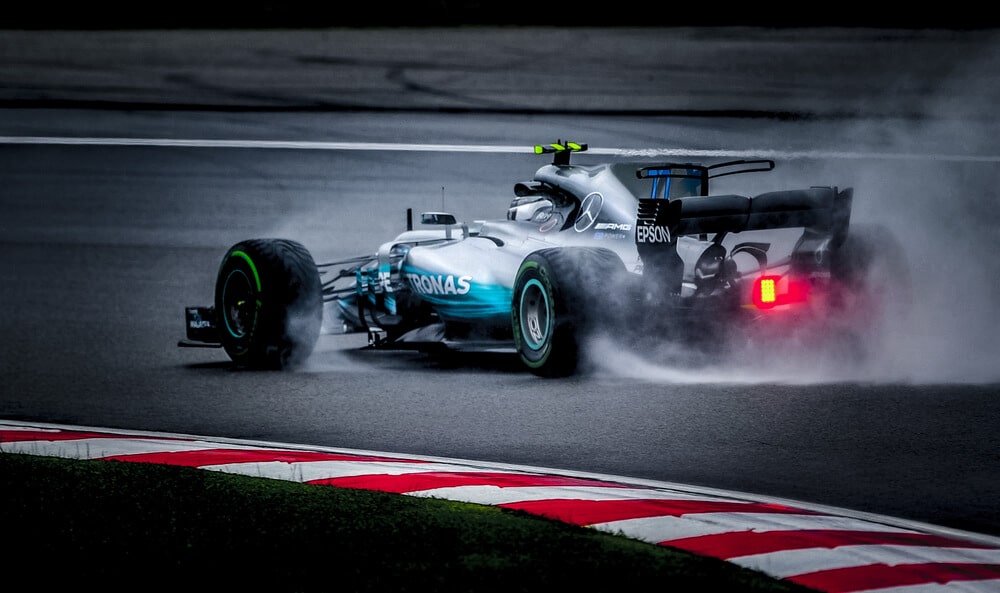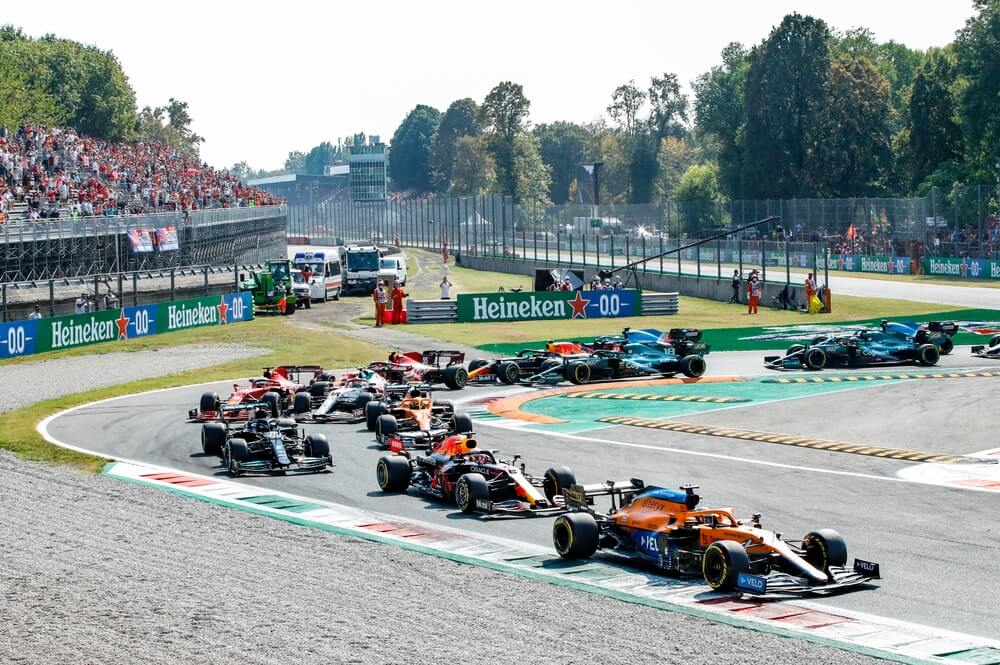Imagine driving a car down straight at high speed. Despite giving the steering wheel what feels like plenty of input, the car doesn’t respond. Instead it continues to head straight even though the driver is trying to turn.
This is what’s known as understeering. It can be a dangerous occurrence in Formula One racing, where the cars are already operating at their limits.
If we focus on understeering in racing cars, it can be described as the car’s inability to follow the driver’s requested direction due to insufficient grip from the front wheels. This means that when trying to turn, the tires slide across the track, resulting in a wide exit from an apex rather than going into it as desired.
In this article, we’re going to look at understeering in F1 and how it affects the performance of a race car. We’ll cover what causes it and what are some strategies that drivers can use to manage it.
Table of Contents
Watch this video to learn more about understeer and oversteer in F1.
What is a Hot Lap?
Let’s take a better look at what understeering is and an overview of understeering in Formula one.
Definition of Understeering
Understeering is a phenomenon that occurs when the front wheels of a vehicle lack the grip to turn as accurately and sharply as desired. This can occur due to insufficient tire contact with the track surface. I’ll make it difficult for the driver to control and steer the car effectively.
Overview of Understeering in Formula One
Understeering is a common issue in Formula One racing, where the cars are designed for maximum speed and agility. As the track surface changes over time, it becomes increasingly difficult to maintain contact with the ground. This can be worsened by poor tire choice or setup of the car, which results in loss of grip or balance.
Key takeaways
Here are some of the key aspects that you should know about regarding Understeering in Formula one:
- Understeering occurs when the front wheels of a car fail to grip and turn as much as desired.
- It is caused by a lack of grip from the tires, which can be due to poor surface conditions or incorrect setup of the car.
- Understeering in F1 racing can lead to loss of control and dangerous situations if not managed properly.
- Some strategies to help manage to understeer include adjusting the Balance of the Car, Increasing tire pressure, and optimizing weight distribution.
- Drivers must remain alert and be able to adapt their driving style when understeering occurs.
- Practice and experience in F1 racing can help drivers to better manage to understeer.
Causes of Understeering
Let’s take a look at the different causes of Understeering in F1:
Car Setup
The first and perhaps most important cause of understeering in F1 is an incorrect setup of the car. This can include incorrect weight distribution, camber angle, tire pressures, and suspension settings which can all contribute to a lack of grip from the front wheels.
If the car is not balanced correctly, the weight of the vehicle will be shifted too far forward or backward and can cause uneven tire wear leading to understeering. Additionally, incorrect camber angles can cause increased drag on one side of the tires, resulting in reduced grip.
Tyre Pressure
Since tires are the point of contact between the car and the track surface, incorrect tire pressures can also cause understeering. Hence, drivers should always ensure that their tire pressures are properly adjusted before a race.
Low tire pressure can cause the tires to deform and flatten out on the track surface, reducing their contact with the ground. This, in turn, results in reduced grip and increased understeer. On the other hand, high tire pressure can cause the tires to be too hard and will not deform, resulting in a lack of grip and also understeer. Hence, drivers should ensure they are running the correct tire pressures in order to reduce understeer.
Weight Distribution
Another common cause of understeering is incorrect weight distribution. If the car is too heavy or too light at the front end, it can result in a lack of grip and will lead to understeer. Drivers should ensure that the weight is distributed evenly across all four wheels to avoid any problems with understeering.

Effects of Understeering
Now that we’ve looked at the causes of understeering let’s take a look at some of the effects:
Loss of Traction
One of the primary effects of understeering is a loss of traction. This is caused by the front wheels being unable to gain the necessary grip on the track surface, resulting in a lack of control over the car.
As a result, drivers will find it hard to steer their cars accurately at high speed and may even spin out if they don’t react quickly enough.
Loss of Vehicle Control
As we’ve already mentioned, understeering can cause a severe lack of control over the car. This is because the car is not able to turn as sharply and accurately as desired, making it very difficult for the driver to keep the vehicle on track.
Reduced Performance
Formula 1 drivers rely on their cars to be able to corner as sharply and accurately as possible in order to keep up with the competition.
The cars are designed to be able to reach maximum performance, but understeering can drastically reduce this potential. This will, in turn, have a negative effect on the driver’s lap times and overall performance.
Techniques to Reduce Understeering
Now that we’ve looked at the causes and effects of understeering, let’s take a look at some techniques that Formula 1 drivers and teams can use to reduce or eliminate this issue:
1. Adjusting the Balance of the Car
The first technique that drivers and teams can use to reduce understeering is to adjust the balance of the car. This can be done by changing various settings on the car such as tire pressures, camber angles, and weight distribution.
By adjusting these settings, drivers can ensure that their cars are balanced correctly and optimized for maximum performance. Doing this should result in improved grip and better cornering capability which will reduce or eliminate understeering altogether.
2. Increasing Tyre Pressure
If the tires are underinflated, they can deform and flatten out on the track surface. That would result in reduced grip and increased understeer. To combat this issue, drivers should always ensure that their tires are inflated to the correct pressure before a race.
However, it is important to note that overinflating the tires can also cause understeering, as the tires will be too hard and rigid and will not deform properly. Hence, drivers should ensure that the tire pressure is set to the optimal level to reduce understeer.
3. Optimizing Weight Distribution
Teams always strive to ensure that their cars are balanced properly and have the right weight distribution for optimal performance. Improper weight distribution can cause the car to be too heavy or too light which can lead to a number of issues, including understeering.
Teams will use a variety of techniques to ensure the weight is distributed evenly across all four wheels. Such as adjusting the ride height or moving components around in the car. Doing this will help them to achieve the optimal weight distribution and reduce understeer.
Frequently asked questions
What is Understeering in Formula 1?
How is Understeering in Formula 1 Avoided?
What are the Effects of Understeering in Formula 1?
Conclusion
Understeering is a major issue for Formula 1 drivers and teams. It can drastically reduce performance, resulting in reduced performance and a lower ranking in the standings. However, with the right techniques and knowledge, drivers can reduce or even eliminate understeering altogether.
To combat this issue, drivers and teams should take the necessary steps to ensure that their cars are properly balanced and optimized for maximum grip on the track surface. By doing this, they can significantly reduce the effects of understeering and increase their chances of success on the track.
Article sources
Learn more about Formula One
Want to learn more about F1? Then visit our Formula 1 glossary and dictionary.



